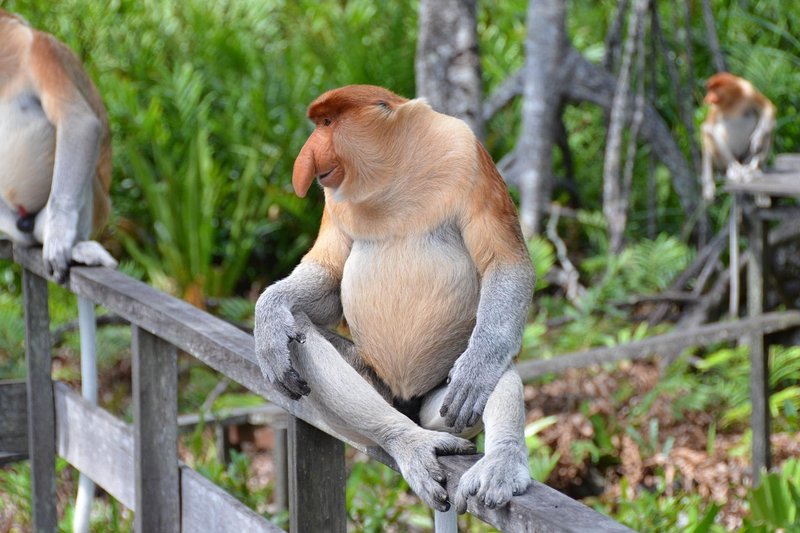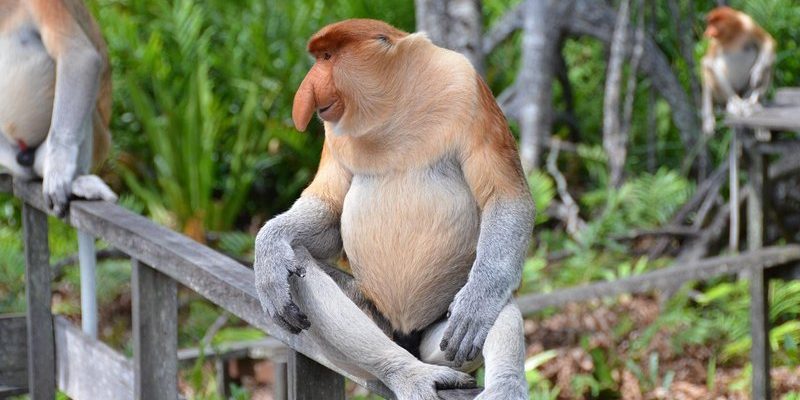
You might picture these monkeys as silly little creatures that just hang around, but they play a significant role in their ecosystems. So, let’s dig into some common myths and misunderstandings about proboscis monkeys that can really help you appreciate them more.
Myth 1: All Monkeys Have a Tail
If you’re thinking that the proboscis monkey is just another monkey with a tail, let me set the record straight. Here’s the thing: proboscis monkeys actually don’t have a tail! Instead, they have a pudgy body and long limbs that help them navigate their forest homes.
Most monkeys, like the playful capuchins and the agile spider monkeys, do have tails that help with balance and communication. But the proboscis monkey has adapted to its environment in a different way. With a strong body and powerful limbs, they can leap from branch to branch without needing a tail for support. Imagine if we all had to rely on just our arms to get around; it’s a different way to see the world!
Their lack of a tail also adds to their unique charm, making them easily identifiable among other primates. So next time someone calls them “just another tail-less monkey,” you can share this fun fact.
Myth 2: Proboscis Monkeys Are Just Silly Creatures
You might think that because they have such a funny-looking nose, proboscis monkeys are all about being goofy and entertaining. But honestly, there’s a lot more to them than meets the eye. That large nose isn’t just for show; it plays a crucial role in attracting mates.
Males have larger noses that help amplify their vocalizations, which they use during mating season. It’s like having a built-in microphone! When a male lets out his loud call, it can convey strength and health to potential partners. In a way, their nose represents their status in the troop, much like a peacock’s feathers attract female attention.
Additionally, these monkeys are incredibly social creatures that live in groups called troops. They communicate with each other through various vocalizations and body language and even display *empathy* towards one another. So, while they might look amusing, they’ve got complex social dynamics that are anything but silly.
Myth 3: Proboscis Monkeys Are Endangered Because of Their Diet
You might hear it said that proboscis monkeys are endangered mainly due to what they eat. But here’s a twist: their diet isn’t the main culprit. The primary threat to their survival comes from habitat loss due to deforestation and human encroachment.
Proboscis monkeys are primarily folivores, meaning they mainly eat leaves, fruit, and seeds. They are particularly fond of certain types of mangrove leaves, which provide essential nutrients. While their specialized diet does make them vulnerable to changes in their environment, it’s not the food itself that’s putting them at risk.
As more forests are cleared for agriculture and urban development, these monkeys lose their homes and food sources. In fact, conservation efforts are focusing on preserving their habitats as a key strategy for helping these incredible animals thrive. Supporting sustainable practices can make a real difference in their survival.
Myth 4: Proboscis Monkeys Are Just Like Any Other Monkey
Let me explain: proboscis monkeys are not just another type of monkey. They’re part of a specific genus called Nasalis, which is unique to Southeast Asia. This means they have distinct behavioral traits that set them apart.
For starters, their strong webbed feet and adaptations for swimming make them excellent at navigating dense forest waterways. While many monkeys might shy away from water, proboscis monkeys often take to it for cooling off or foraging. Imagine a monkey diving into a river like a pro swimmer!
Moreover, proboscis monkeys have a more pronounced sexual dimorphism compared to other monkey species. Males and females differ not only in size but also in physical features, like that iconic nose! This helps differentiate them much easier than other species where the differences can be subtle.
Myth 5: Proboscis Monkeys Are Lazy
You might have seen a proboscis monkey lounging around and thought they were just lazy. But in reality, these monkeys are quite the opposite! They’re often active, social creatures that can spend hours foraging for food and moving through the treetops.
Just like us, they have their moments of rest, particularly during the hottest parts of the day. But when they’re not napping, they’re frequently engaged in social activities, grooming each other, and interacting with troop members. This social structure is essential for their well-being and helps strengthen bonds within the group.
So, when you see one taking a break, remember that they’re just doing what any smart creature does—conserving energy for their next adventure!
Myth 6: All Proboscis Monkeys Live in Groups
Another common misconception is that proboscis monkeys are always found in large, cohesive groups. While it’s true that many of them do live in troops, their social structure can be more fluid than you might expect. Troop sizes can vary greatly.
Some male proboscis monkeys may live a more solitary life, especially if they are not dominant enough to maintain a permanent position in a troop. Other times, females might band together in smaller groups to raise their young. It’s like a constantly shifting social scene!
This flexibility in their social structure can be quite advantageous, especially in areas where food is scarce. By adapting their social behaviors, these monkeys can better navigate their environment and find resources, proving that they’re more than just straightforward group-living animals.
Wrapping It Up
So there you have it—some common myths and misconceptions about the proboscis monkey. From their unique anatomical features to their complex social structures, these monkeys are much more fascinating than many people realize. By separating the facts from fiction, you can appreciate these incredible creatures for all that they are.
Next time you see a photo or a video of a proboscis monkey, you’ll know it’s not just a silly animal, but a vital part of its ecosystem facing real challenges. Understanding their realities helps us support their conservation and appreciate the rich biodiversity of our planet. Whether you’re an animal lover or just curious about the natural world, the more we learn, the more we can help protect these unique beings.

